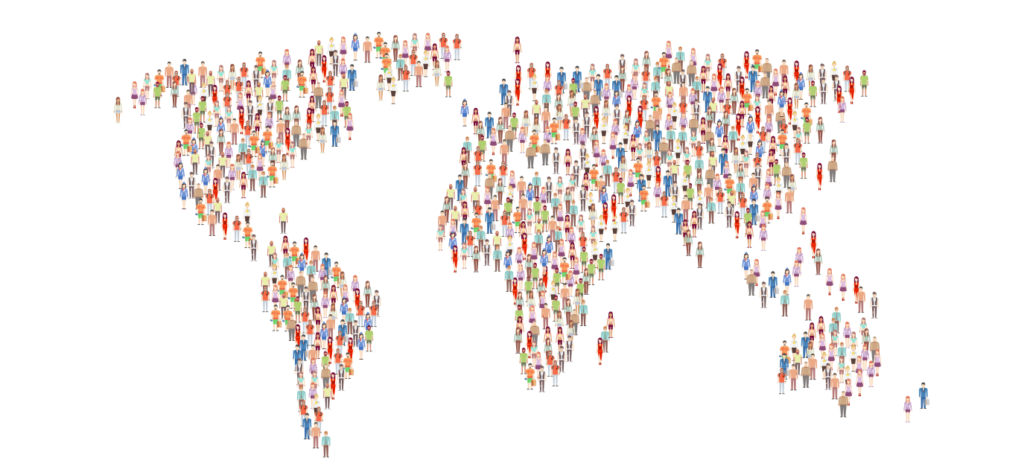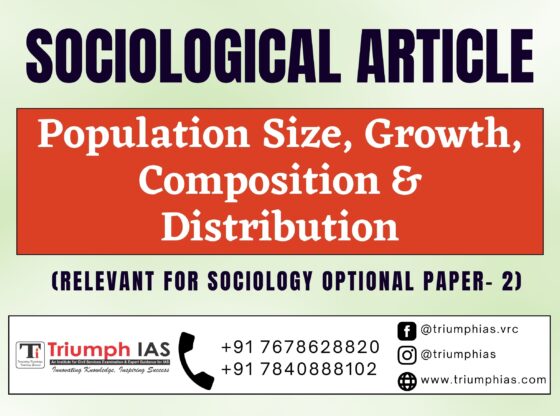Population Size, Growth, Composition & Distribution
Relevant for sociology optional Paper- 2 (Unit- 13 : Social Changes in India)

India, with a population of over 1.3 billion people, is the second-most populous country in the world, trailing only behind China. India’s population is also the fastest-growing in the world, increasing by approximately 15 million people each year. These numbers are staggering, and they have significant implications for the country’s economy, environment, and overall development.
Population Size: India’s population size is significant, and it continues to grow at a rapid pace. The latest census, conducted in 2011, revealed that India’s population had increased by 181 million people in the previous decade, representing a growth rate of 17.64%. This growth rate is lower than the previous decade, which saw a growth rate of 21.54%, but it is still significant. India’s population is projected to reach 1.7 billion by 2050, making it the most populous country in the world.
Growth: India’s population growth rate has been a subject of debate for many years. The country’s population has grown at an alarming rate in the past, but it has shown some signs of slowing down in recent years. India’s current population growth rate is 1.08%, which is lower than the previous decade’s rate of 1.64%. However, this growth rate is still higher than the global average of 1.05%, and it is higher than the growth rates of many developed countries.
The reasons behind India’s high population growth rate are complex and varied. One of the main factors is the high fertility rate in the country. The total fertility rate (TFR) in India is currently 2.2, which is lower than the previous decade’s TFR of 2.5. However, it is still higher than the replacement level of 2.1, which is the number of children needed to maintain a stable population size. India’s high fertility rate is a result of many factors, including a lack of education and awareness about family planning, poverty, and cultural beliefs.
Composition: India’s population is diverse, and it is made up of many different ethnic, linguistic, and religious groups. The largest ethnic group in India is the Indo-Aryans, who make up approximately 72% of the population. The Dravidians are the second-largest ethnic group, comprising around 25% of the population. Other significant ethnic groups include the Mongoloids, who make up 2.5% of the population, and the Negroids, who make up 0.5% of the population.
India is also home to many different languages, with over 19,500 distinct mother tongues spoken across the country. Hindi is the most widely spoken language, followed by Bengali, Telugu, Marathi, Tamil, and Urdu. English is also widely spoken and is the primary language of business, education, and government.
India is known for its religious diversity, with Hinduism being the most widely practiced religion, followed by Islam, Christianity, Sikhism, Buddhism, and Jainism. Other religions, including Zoroastrianism and Judaism, also have a presence in India.
Distribution: India’s population is not evenly distributed across the country, with some areas being more densely populated than others. The most populous states in India are Uttar Pradesh, Maharashtra, and Bihar, which together account for around one-third of the country’s population. The least populous states are Sikkim, Mizoram, and Arunachal Pradesh, which have a combined population of around 3 million people.
India’s urban population has been growing at a rapid pace in recent years. The urban population increased from 286 million in 2001 to 377 million in 2011, representing a growth rate of 31.8%. This growth rate is higher than the overall population growth rate, indicating a shift towards urbanization in India. The growth of urban areas has significant implications for India’s infrastructure, environment, and economy.
The rapid growth of India’s population, combined with the country’s diverse composition and uneven distribution, presents many challenges for the government and policymakers. The government has implemented various initiatives to address these challenges, including family planning programs, education initiatives, and rural development schemes. However, much work remains to be done to ensure that India’s population growth is sustainable and equitable.
In conclusion, India’s population size, growth, composition, and distribution are complex and multifaceted issues that have significant implications for the country’s development. While India’s population growth rate has shown some signs of slowing down, it is still higher than the global average, and the country’s population is projected to continue growing at a rapid pace. India’s diverse population composition and uneven distribution pose challenges for policymakers, but the government has implemented various initiatives to address these challenges. The growth of India’s urban population has also presented challenges and opportunities, highlighting the need for sustainable and equitable development.
For more such free UPSC notes, Articles, News & Views Join our Telegram Channel. https://t.me/triumphias
Click the link below to see the details about the UPSC – Civils courses offered by Triumph IAS. https://triumphias.com/pages-all-courses.php


